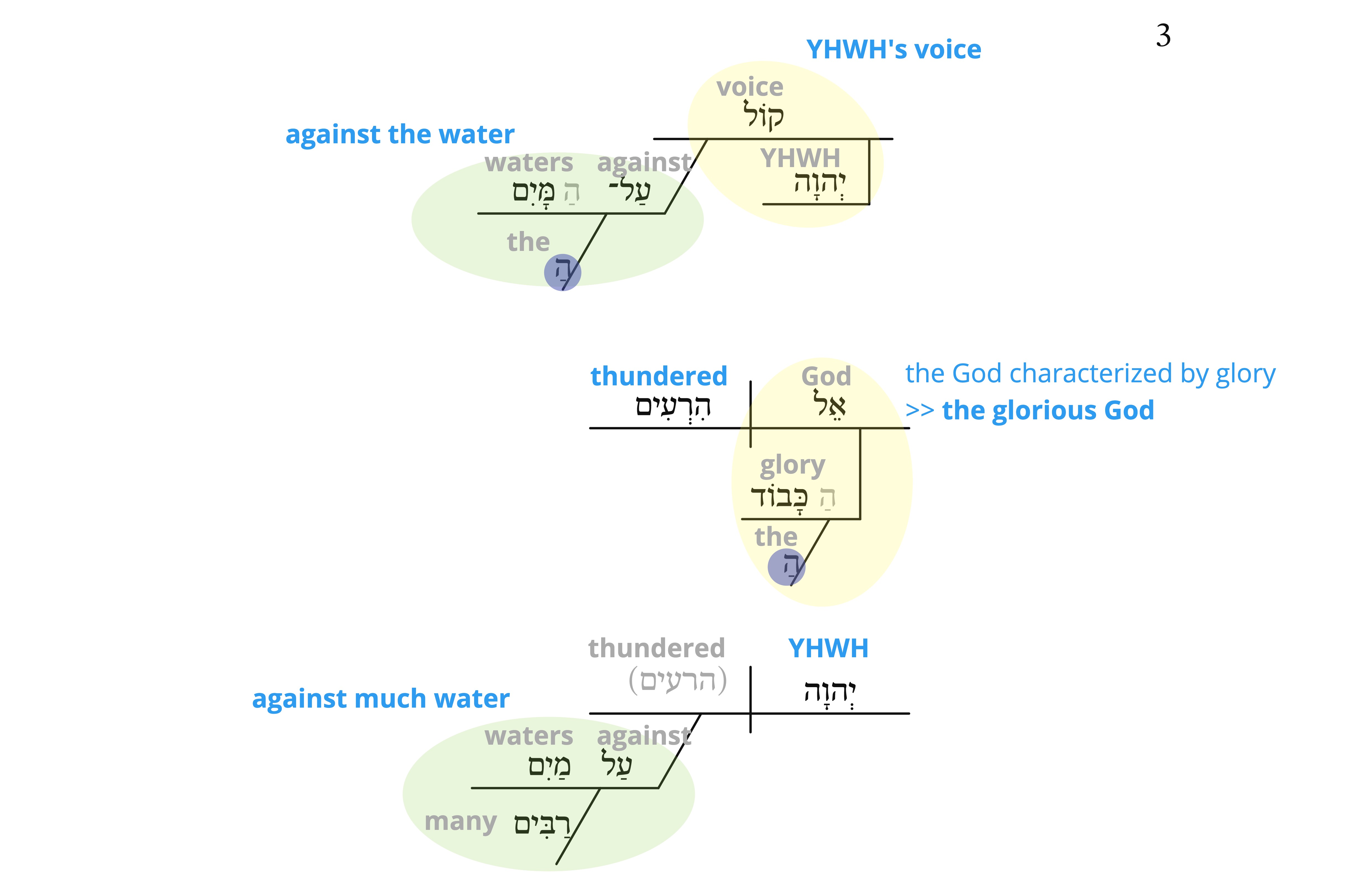Close-but-Clear
Introduction
The close-but-clear translation exists to provide a window into the Hebrew text (grammar, syntax, and wording) for non-Hebrew readers of the Psalms: Layer by Layer materials. It is not intended to be a stand-alone translation. The CBC is used as the primary display text (along with the Hebrew) for most analytical visualisations. It is also used as the display text for most videos.
Steps
1. Glosses from Phrase-Level Semantics
View the phrase-level semantics diagram and use the word/phrase glosses (bold-blue text) to begin forming a the CBC rendering.
For example, the phrase-level diagram for Psalm 29:3 is as follows:

Putting the glosses together to form sentences (or sentence fragments, depending on the Hebrew grammar), results in the following:
- YHWH's voice against the water.
- The glorious God thundered.
- YHWH against much water.
This forms the base of the CBC. After completing this initial step, some clauses may be considered complete. Other clauses will need to be further modified.
2. Modification
Fill in gaps in the translation as necessary. For example, you may need to add an English copula ("to be" verb) for Hebrew null copular clauses, since these are not glossed on the diagram. You may also need to add elements that are elided in the grammatical diagram. Use parentheses for this. For example, Psalm 29:3c "YHWH against much water" should become "YHWH (thundered) against much water." Other modifications may be necessary where the resulting English text is incoherent or misleading.
3. Punctuation
Add proper punctuation. Follow the conventions included in "Conventions for Close-but-clear" below.
Conventions for Close-but-clear
Spelling
As with all CDBR materials, follow UK English spelling conventions.
Capitalisation
Follow standard English conventions. This includes the following:
- Do not capitalise pronouns referring to God. (Any ambiguity as to a referent should be dealt with in Participant Analysis.)
- Do not capitalise terms such as “god,” “lord,” or “king” unless used as a name or direct title of God. For examples: In Ps 8, “YHWH, our lord” not “YHWH, our Lord;” In Ps 10:16, “YHWH is king forever,” not “YHWH is King forever.”
Vocatives
Follow standard English conventions. This includes the following:
- Offset vocative with commas.
- Do not add “O” to the vocative (e.g. "Lord" not "O Lord").
- Do not add "you" to the vocative (e.g. Ps 2:10a "And now, kings, be wise" not "And now, you kings, be wise").
Punctuation
In general, follow standard English conventions.
- Modals: As a default, volitive modals (imperatives, jussives, and cohortatives) should be punctuated with exclamation marks (as opposed to full stops). Use of full stops may be warranted upon consideration of other factors (e.g. clause length, emotional content).
- Sentence fragments: Sentence fragments may be punctuated with exclamation marks. For example, Psalm 29:3a (a sentence fragment) is an exclamation. It might be punctuated with an exclamation mark: "YHWH's voice against the water!"
- Synonymous poetic cola: Use semicolons between synonymous poetic cola.
Tetragrammaton
Write as YHWH (when reading in oral materials, read as "Lord").
Transliteration
Follow SBL simple version.
Supplied Information
Indicate supplied content in square brackets (e.g., "YHWH [thundered] against much water" in Ps 29:3).